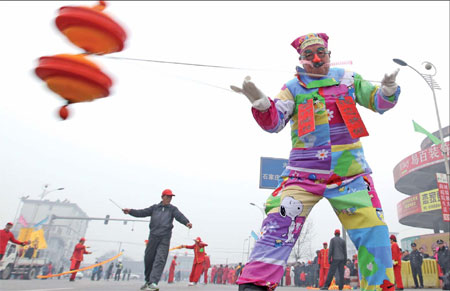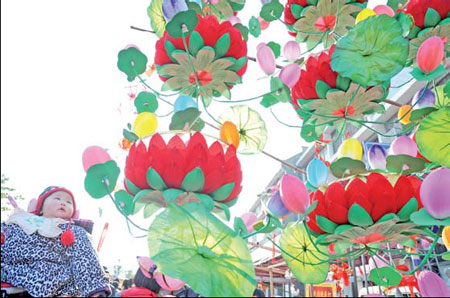Party with 节
Updated: 2013-03-08 13:29
By Xiao Chu (China Daily)
|
||||||||

|
Top and above: People celebrate the traditional Lantern Festival in Hebei and Jiangsu provinces. The character, or festivals, is related to celebrations. Photos Provided to China Daily |
The character that can create an instant festival despite its prosaic roots
The character 节 is, in a word, an instant party-attach it to the end of just about anything and you've got yourself a holiday. Tack it on to 劳动 (láodòng), or labor, and you've got 劳动节 (Láodòngjié), Labor Day; add it to 妇女 (fùnǚ), woman, and you've got 妇女节 (Fùnǚjié), Women's Day. Add it to spring, 春 (chūn), and you've got the biggest holiday of the year: 春节(Chūnjié), or Spring Festival. 节, in other words, has the power to transform the dead of winter into a raging, baijiu-fueled, firework-popping celebration.
Given its alchemical powers, you might be surprised at 节's rather prosaic roots - its original meaning, as recorded in bronzeware inscriptions (1300 BC-200 BC), was "bamboo joint", the ridges along poles of bamboo. At that time, 节 was written as 節, which combined the radicals at the top of the character for bamboo, 竹 (zhú), with the pronunciation character 即 (jí).
The appearance of the character started to change during the Qin Dynasty (221 BC-207 BC), when cursive writing simplified the ? at the top of 節 to 艹. Later still, people started leaving out the left side of the character 即, simplifying it into the modern 节.
The meaning of 节, on the other hand, took a much more convoluted path. Around the Han Dynasty (206 BC-AD 220), dictionaries began listing a second definition for节, "bamboo cord", thanks to the resemblance between bamboo ridges and knotted up bits of twine.
Here's where the semantic gods of association begin to run wild. Because twine was used as a restraint, 节 gave birth to 节制 (jiézhì), which means "restrict" or "moderate." This spun off a host of new words related to restraint or restriction: 节约 (jiéyuē) and 节俭 (jiéjiǎn), for example, both refer to frugality; 节食 (jiéshí) means to diet; 节欲 (jiéyù) is abstinence and节哀 (jié'āi) refers to overcoming grief. When people pass away, we often say 节哀顺变 (jié'āi shùnbiàn), which is short for 节制哀伤 (jiézhì āishāng) "restrain grief", and 顺应变故 (shùnyìng biàngù) "accept misfortune".
节 took another interesting turn with the word 符节 (fújié), which in ancient China referred to the bamboo certifications given to royal envoys. Diplomats came to be called 使节 (shǐjié), which in turn gave way to an army of terms related to the messengers' supposedly noble characters. Among these are 气节 (qìjié, integrity) and 节操 (jiécāo, moral principles). In ancient Chinese culture节操 was extremely important, a sentiment expressed in the phrase,"饿死事小,失节事大"(è sǐ shì xiǎo, shījié shì dà), which means that starving to death is nothing compared with losing one's integrity.
A third line of semantic evolution was based on the observation that bamboo joints occur one after the other. As a result, 节节 came to describe something that occurs steadily or in succession. During a war, two defeats followed by a retreat is called 节节败退 (jié jié bàituì). When prices continually rise it's called 节节上升 (jié jié shàngshēng). The saying 芝麻开花-节节高 (zhīma kāihuā - jié jié gāo, sesame flowers open - and grow steadily tall) means that things are always changing for the better, like a sesame flower blossoming upwards.
Because bamboo joints divide the pole into sections, 节 is also used to describe things in life that have stages. Book chapters and sections are called 章节 (zhāngjié); performance order is called 节目 (jiémù); and seasons are called 季节 (jìjié) and 节气 (jiéqì). It's this that led to the use of 节 to refer to holidays, which were originally used to mark seasonal changes. In addition to 春节 (Chūnjié), there's also 清明节 (Qīngmíngjié) or Tomb Sweeping Day, 端午节 (Duānwǔjié) or Dragon Boat Festival, 中秋节 (Zhōngqiūjié) or Mid-Autumn Festival, and so on. Go ahead, try and invent your own. My first nomination: 巧克力节 (Qiǎokèlìjié, Chocolate Festival).
Translated by Liz Tung
Courtesy of The World of Chinese, www.theworldofchinese.com
The World of Chinese
(China Daily 03/01/2013 page17)

 In Photos: 7.0-magnitude quake hits Sichuan
In Photos: 7.0-magnitude quake hits Sichuan
 Li Na on Time cover, makes influential 100 list
Li Na on Time cover, makes influential 100 list
 FBI releases photos of 2 Boston bombings suspects
FBI releases photos of 2 Boston bombings suspects
 World's wackiest hairstyles
World's wackiest hairstyles
 Sandstorms strike Northwest China
Sandstorms strike Northwest China
 Never-seen photos of Madonna on display
Never-seen photos of Madonna on display
 H7N9 outbreak linked to waterfowl migration
H7N9 outbreak linked to waterfowl migration
 Dozens feared dead in Texas plant blast
Dozens feared dead in Texas plant blast
Most Viewed
Editor's Picks

|

|

|

|

|

|
Today's Top News
Live report: 7.0-magnitude quake hits Sichuan, heavy casualties feared
Boston suspect cornered on boat
Cross-talk artist helps to spread the word
'Green' awareness levels drop in Beijing
Palace Museum spruces up
First couple on Time's list of most influential
H7N9 flu transmission studied
Trading channels 'need to broaden'
US Weekly

|

|








